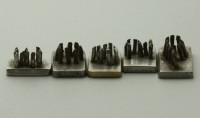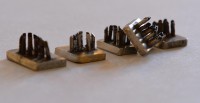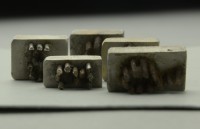 An anonymous donor has given the Auschwitz Museum five stamps used to tattoo prisoners at the death camp. Each metal block is embedded with a group of small, sharp needles arranged in the shape of a number, in this case one zero, two threes and two that could be either sixes or nines depending on which end is up. Only one other Nazi tattooing tool is known to exist — it’s in the Military Medical Museum in Saint Petersburg — which makes these grim survivals as rare as they are compelling.
An anonymous donor has given the Auschwitz Museum five stamps used to tattoo prisoners at the death camp. Each metal block is embedded with a group of small, sharp needles arranged in the shape of a number, in this case one zero, two threes and two that could be either sixes or nines depending on which end is up. Only one other Nazi tattooing tool is known to exist — it’s in the Military Medical Museum in Saint Petersburg — which makes these grim survivals as rare as they are compelling.
“It is one of the most important findings of the recent years. We couldn’t believe that original tools for tattooing prisoners could be discovered after such a long time,” emphasised Dr. Piotr M.A. Cywiński, Director of the Auschwitz Museum. “Even a tattooed number is rare to be seen now as the last prisoners pass away. Those stamps will greatly enrich the new main exhibition that is currently being prepared,” he added.
 To preserve the anonymity of the donor, the museum has released limited information about the artifacts. All they’re saying right now is that the stamps were found on or near one of the evacuation routes the Nazis used to move prisoners west when the Soviets were baring down on them from the east in January of 1945. About 56,000 prisoners were marched out of Auschwitz in columns through Upper and Lower Silesia. Most met up with trains and were transported the rest of the way. The routes covered an area 30 to 35 miles north and south of the Auschwitz-Birkenau complex, and one march was 155 miles long; a lot of ground in which to find five small metal plates.
To preserve the anonymity of the donor, the museum has released limited information about the artifacts. All they’re saying right now is that the stamps were found on or near one of the evacuation routes the Nazis used to move prisoners west when the Soviets were baring down on them from the east in January of 1945. About 56,000 prisoners were marched out of Auschwitz in columns through Upper and Lower Silesia. Most met up with trains and were transported the rest of the way. The routes covered an area 30 to 35 miles north and south of the Auschwitz-Birkenau complex, and one march was 155 miles long; a lot of ground in which to find five small metal plates.
Tattooing of prisoners began at Auschwitz in 1941 with Soviet prisoners of war. Serial numbers were first patches sewn into uniforms or attached with badges or armbands, but as more prisoners arrived and more of them died, clothing-based identification was found wanting. If their uniforms were tattered or lost, then their serial numbers were gone too. Prisoners also sometimes traded their worn clothes for pieces in better condition that had belonged to deceased inmates. Tattoos were durable and could not be exchanged.
 The first tattoos were applied using a metal stamp with interchangeable numbered plates. The needled stamps were punched against the prisoner’s skin and then ink rubbed into the wound. The early Soviet prisoners were tattooed on the chest. Later the location of the tattoo moved to the left upper forearm, first the outside and then the inside. The metal plate stamps were eventually replaced with fixed needles on a wooden shaft that were dipped in ink and then pushed into the skin.
The first tattoos were applied using a metal stamp with interchangeable numbered plates. The needled stamps were punched against the prisoner’s skin and then ink rubbed into the wound. The early Soviet prisoners were tattooed on the chest. Later the location of the tattoo moved to the left upper forearm, first the outside and then the inside. The metal plate stamps were eventually replaced with fixed needles on a wooden shaft that were dipped in ink and then pushed into the skin.
The tattoo was applied to prisoners at registration when they were assigned their serial numbers. In spring of 1942, Auschwitz authorities expanded the pool of tattooed prisoners from Soviets to other prisoners (Jews, Roma, reeducation candidates, political prisoners), retroactively tattooing people who were already registered. Eventually everyone who survived the initial sorting process was tattooed. People who were sent directly to the gas chambers were not.
 Although other camps appear to have used serial number tattoos at times, Auschwitz was the only camp to have systematically tattooed its prisoners. The recently unveiled stamps, therefore, are of great significance to the history of Auschwitz. Up until now, the museum has only had a replica of the Military Medical Museum’s tattooing device on display. The plates will be kept in the museum’s archives while the main exhibition area is revamped, after which they will go on display in the redesigned space.
Although other camps appear to have used serial number tattoos at times, Auschwitz was the only camp to have systematically tattooed its prisoners. The recently unveiled stamps, therefore, are of great significance to the history of Auschwitz. Up until now, the museum has only had a replica of the Military Medical Museum’s tattooing device on display. The plates will be kept in the museum’s archives while the main exhibition area is revamped, after which they will go on display in the redesigned space.